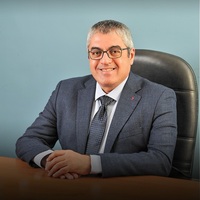Conference Proceedings by Joshua Punnoose
Papers by Joshua Punnoose
Journal of Visualized Experiments, Mar 10, 2023

Medical Physics, Jul 21, 2016
Purpose: A computational toolkit ( 3.0) has been developed to calculate x-ray spectra based... more Purpose: A computational toolkit ( 3.0) has been developed to calculate x-ray spectra based on the tungsten anode spectral model using interpolating cubic splines (TASMICS) algorithm, updating previous work based on the tungsten anode spectral model using interpolating polynomials (TASMIP) spectral model. The toolkit includes a (The Mathworks, Natick, MA) function library and improved user interface (UI) along with an optimization algorithm to match calculated beam quality with measurements. Methods: The code generates x-ray spectra (photons/mm 2 /mAs at 100 cm from the source) using TASMICS as default (with TASMIP as an option) in 1 keV energy bins over beam energies 20-150 kV, extensible to 640 kV using the TASMICS spectra. An optimization tool was implemented to compute the added filtration (Al and W) that provides a best match between calculated and measured x-ray tube output (mGy/mAs or mR/mAs) for individual x-ray tubes that may differ from that assumed in TASMICS or TASMIP and to account for factors such as anode angle. Results: The median percent difference in photon counts for a TASMICS and TASMIP spectrum was 4.15% for tube potentials in the range 30-140 kV with the largest percentage difference arising in the low and high energy bins due to measurement errors in the empirically based TASMIP model and inaccurate polynomial fitting. The optimization tool reported a close agreement between measured and calculated spectra with a Pearson coefficient of 0.98. Conclusions: The computational toolkit, , has been updated to version 3.0, validated against measurements and existing models, and made available as open source code. Video tutorials for the function library, UI, and optimization tool are available.

Proceedings of SPIE, Mar 3, 2017
Introduction-Fluoroscopically guided procedures often involve repeated acquisitions for C-arm pos... more Introduction-Fluoroscopically guided procedures often involve repeated acquisitions for C-arm positioning at the cost of radiation exposure and time in the operating room. A virtual fluoroscopy system is reported with the potential of reducing dose and time spent in C-arm positioning, utilizing three key advances: robust 3D-2D registration to a preoperative CT; real-time forward projection on GPU; and a motorized mobile C-arm with encoder feedback on C-arm orientation. Method-Geometric calibration of the C-arm was performed offline in two rotational directions (orbit α, orbit β). Patient registration was performed using image-based 3D-2D registration with an initially acquired radiograph of the patient. This approach for patient registration eliminated the requirement for external tracking devices inside the operating room, allowing virtual fluoroscopy using commonly available systems in fluoroscopically guided procedures within standard surgical workflow. Geometric accuracy was evaluated in terms of projection distance error (PDE) in anatomical fiducials. A pilot study was conducted to evaluate the utility of virtual fluoroscopy to aid C-arm positioning in image guided surgery, assessing potential improvements in time, dose, and agreement between the virtual and desired view. Results-The overall geometric accuracy of DRRs in comparison to the actual radiographs at various C-arm positions was PDE (mean ± std) = 1.6 ± 1.1 mm. The conventional approach required on average 8.0 ± 4.5 radiographs spent "fluoro hunting" to obtain the desired view. Positioning accuracy improved from 2.6° ± 2.3° (in α) and 4.1° ± 5.1° (in β) in the conventional approach to 1.5° ± 1.3° and 1.8° ± 1.7°, respectively, with the virtual fluoroscopy approach. Conclusion-Virtual fluoroscopy could improve accuracy of C-arm positioning and save time and radiation dose in the operating room. Such a system could be valuable to training of fluoroscopy technicians as well as intraoperative use in fluoroscopically guided procedures.

Journal of medical imaging, Feb 13, 2018
Positioning of an intraoperative C-arm to achieve clear visualization of a particular anatomical ... more Positioning of an intraoperative C-arm to achieve clear visualization of a particular anatomical feature often involves repeated fluoroscopic views, which cost time and radiation exposure to both the patient and surgical staff. A system for virtual fluoroscopy (called FluoroSim) that could dramatically reduce time-and dosespent "fluoro-hunting" by leveraging preoperative computed tomography (CT), encoded readout of C-arm gantry position, and automatic 3D-2D image registration has been developed. The method is consistent with existing surgical workflow and does not require additional tracking equipment. Real-time virtual fluoroscopy was achieved via mechanical encoding of the C-arm motion, C-arm geometric calibration, and patient registration using a single radiograph. The accuracy, time, and radiation dose associated with C-arm positioning were measured for FluoroSim in comparison with conventional methods. Five radiology technologists were tasked with acquiring six standard pelvic views pertinent to sacro-illiac, anterior-inferior iliac spine, and superior-ramus screw placement in an anthropomorphic pelvis phantom using conventional and FluoroSim approaches. The positioning accuracy, exposure time, number of exposures, and total time for each trial were recorded, and radiation dose was characterized in terms of entrance skin dose and in-room scatter. The geometric accuracy of FluoroSim was measured to be 1.6 AE 1.1 mm. There was no significant difference (p > 0.05) observed in the accuracy or total elapsed time for C-arm positioning. However, the total fluoroscopy time required to achieve the desired view decreased by 4.1 s (4.7 AE 3.6 s for conventional, compared with 0.5 AE 0.0 s for FluoroSim, p < 0.05), and the total number of exposures reduced by 4.0 (6.4 AE 4.8 for conventional, compared with 2.0 AE 0.0 for FluoroSim, p < 0.05). These reductions amounted to a 50% to 78% decrease in patient entrance skin dose and a 55% to 70% reduction in in-room scatter. FluoroSim was found to reduce the radiation exposure required in C-arm positioning without diminishing positioning time or accuracy, providing a potentially valuable tool to assist technologists and surgeons.

Research Square (Research Square), Jun 16, 2023
Background Tension in the spinal cord is a trademark of tethered cord syndrome. Unfortunately, 45... more Background Tension in the spinal cord is a trademark of tethered cord syndrome. Unfortunately, 45 existing tests cannot quantify tension across the bulk of the cord, making the diagnostic evaluation of stretch ambiguous. A potential non-destructive metric for spinal cord tension is 47 ultrasound-derived shear wave velocity (SWV). The velocity is sensitive to tissue elasticity and 48 boundary conditions including strain. We use the term Ultrasound Tensography to describe the 49 acoustic evaluation of tension with SWV. 50 Methods Our solution "Tethered cord Assessment with Ultrasound Tensography (TAUT)" was utilized in three sub-studies: finite element simulations, a cadaveric benchtop validation, and a neurosurgical case series. The simulation computed SWV for given tensile forces. The induced tension cadaveric model validated the SWV-tension relationship. Lastly, SWV was measured intraoperatively in patients diagnosed with tethered cord who underwent surgical treatment (spinal column shortening). The surgery alleviates tension by decreasing the vertebral column length. Results Here we observe a strong linear relationship between tension and squared SWV across the preclinical sub-studies. Higher tension induces faster shear waves in the simulation (R 2 = 0.984) and cadaveric (R 2 = 0.951) models. The SWV decreases in all neurosurgical procedures (p<0.001). Moreover, TAUT has a c-statistic of 0.962 (0.92-1.00), detecting all tethered cords. Conclusions This study presents the first clinical metric of spinal cord tension. Strong agreement among computational, cadaveric, and clinical studies demonstrates the utility of ultrasoundinduced SWV for quantitative intraoperative feedback. This technology is positioned to enhance tethered cord diagnosis, treatment, and post-operative monitoring as it differentiates stretched from healthy cords.
2023 11th International IEEE/EMBS Conference on Neural Engineering (NER)
Journal of Visualized Experiments
<p>The median head-tilt angle associated with patent airway (125.3° ± 11.9°) was significan... more <p>The median head-tilt angle associated with patent airway (125.3° ± 11.9°) was significantly different from median head-tilt angle (108.2° ± 17.1°) associated with an obstructed airway (p = 0.0045).</p
<p>Correlation between Head-tilt Angle of Patent Airways and Age, Weight, and Gestational A... more <p>Correlation between Head-tilt Angle of Patent Airways and Age, Weight, and Gestational Age of Newborn Infants.</p

Medical Physics, 2016
Purpose: A computational toolkit ( 3.0) has been developed to calculate x-ray spectra based... more Purpose: A computational toolkit ( 3.0) has been developed to calculate x-ray spectra based on the tungsten anode spectral model using interpolating cubic splines (TASMICS) algorithm, updating previous work based on the tungsten anode spectral model using interpolating polynomials (TASMIP) spectral model. The toolkit includes a (The Mathworks, Natick, MA) function library and improved user interface (UI) along with an optimization algorithm to match calculated beam quality with measurements. Methods: The code generates x-ray spectra (photons/mm 2 /mAs at 100 cm from the source) using TASMICS as default (with TASMIP as an option) in 1 keV energy bins over beam energies 20-150 kV, extensible to 640 kV using the TASMICS spectra. An optimization tool was implemented to compute the added filtration (Al and W) that provides a best match between calculated and measured x-ray tube output (mGy/mAs or mR/mAs) for individual x-ray tubes that may differ from that assumed in TASMICS or TASMIP and to account for factors such as anode angle. Results: The median percent difference in photon counts for a TASMICS and TASMIP spectrum was 4.15% for tube potentials in the range 30-140 kV with the largest percentage difference arising in the low and high energy bins due to measurement errors in the empirically based TASMIP model and inaccurate polynomial fitting. The optimization tool reported a close agreement between measured and calculated spectra with a Pearson coefficient of 0.98. Conclusions: The computational toolkit, , has been updated to version 3.0, validated against measurements and existing models, and made available as open source code. Video tutorials for the function library, UI, and optimization tool are available.
<p>There is at least a 95% probability that an airway will be patent between head-tilt angl... more <p>There is at least a 95% probability that an airway will be patent between head-tilt angle 144–150°. Y-axis represents the proportion of patent airways with standard error of proportion and X-axis represents 15° bins of head-tilt angles.</p
<p>Logistic Regression Model of Patent Airway vs Head-tilt Angle.</p

Proceedings of SPIE--the International Society for Optical Engineering, Jan 11, 2017
Fluoroscopically guided procedures often involve repeated acquisitions for C-arm positioning at t... more Fluoroscopically guided procedures often involve repeated acquisitions for C-arm positioning at the cost of radiation exposure and time in the operating room. A virtual fluoroscopy system is reported with the potential of reducing dose and time spent in C-arm positioning, utilizing three key advances: robust 3D-2D registration to a preoperative CT; real-time forward projection on GPU; and a motorized mobile C-arm with encoder feedback on C-arm orientation. Geometric calibration of the C-arm was performed offline in two rotational directions (orbit α, orbit β). Patient registration was performed using image-based 3D-2D registration with an initially acquired radiograph of the patient. This approach for patient registration eliminated the requirement for external tracking devices inside the operating room, allowing virtual fluoroscopy using commonly available systems in fluoroscopically guided procedures within standard surgical workflow. Geometric accuracy was evaluated in terms of p...

Sensors
Sentinel lymph node (SLN) biopsy is an integral part of treatment planning for a variety of cance... more Sentinel lymph node (SLN) biopsy is an integral part of treatment planning for a variety of cancers as it evaluates whether a tumor has metastasized, an event that significantly reduces survival probability. However, this invasive procedure is associated with patient morbidity, and misses small metastatic deposits, resulting in the removal of additional nodes for tumors with high metastatic probability despite a negative SLN biopsy. To prevent this over-treatment and its associated morbidities for patients that were truly negative, we propose a tissue oxygen imaging method called Photoacoustic Lifetime Imaging (PALI) as an alternative or supplementary tool for SLN biopsy. As the hyper-metabolic state of cancer cells significantly depresses tissue oxygenation compared to normal tissue even for small metastatic deposits, we hypothesize that PALI can sensitively and specifically detect metastases. Before this hypothesis is tested, however, PALI’s maximum imaging depth must be evaluated...

PLOS ONE, 2016
Head-tilt maneuver assists with achieving airway patency during resuscitation. However, the relat... more Head-tilt maneuver assists with achieving airway patency during resuscitation. However, the relationship between angle of head-tilt and airway patency has not been defined. Our objective was to define an optimal head-tilt position for airway patency in neonates (age: 0-28 days) and young infants (age: 29 days-4 months). We performed a retrospective study of head and neck magnetic resonance imaging (MRI) of neonates and infants to define the angle of head-tilt for airway patency. We excluded those with an artificial airway or an airway malformation. We defined head-tilt angle a priori as the angle between occipito-ophisthion line and ophisthion-C7 spinous process line on the sagittal MR images. We evaluated medical records for Hypoxic Ischemic Encephalopathy (HIE) and exposure to sedation during MRI. We analyzed MRI of head and neck regions of 63 children (53 neonates and 10 young infants). Of these 63 children, 17 had evidence of airway obstruction and 46 had a patent airway on MRI. Also, 16/63 had underlying HIE and 47/63 newborn infants had exposure to sedative medications during MRI. In spontaneously breathing and neurologically depressed newborn infants, the head-tilt angle (median ± SD) associated with patent airway (125.3°± 11.9°) was significantly different from that of blocked airway (108.2°± 17.1°) (Mann Whitney U-test, p = 0.0045). The logistic regression analysis showed that the proportion of patent airways progressively increased with an increasing head-tilt angle, with > 95% probability of a patent airway at head-tilt angle 144-150°.

Journal of Medical Imaging, Feb 13, 2018
Positioning of an intraoperative C-arm to achieve clear visualization of a particular anatomical ... more Positioning of an intraoperative C-arm to achieve clear visualization of a particular anatomical feature often involves repeated fluoroscopic views, which cost time and radiation exposure to both the patient and surgical staff. A system for virtual fluoroscopy (called FluoroSim) that could dramatically reduce time- and dose-spent &amp;amp;amp;amp;amp;amp;amp;amp;amp;amp;amp;amp;amp;amp;quot;fluoro-hunting&amp;amp;amp;amp;amp;amp;amp;amp;amp;amp;amp;amp;amp;amp;quot; by leveraging preoperative computed tomography (CT), encoded readout of C-arm gantry position, and automatic 3D-2D image registration has been developed. The method is consistent with existing surgical workflow and does not require additional tracking equipment. Real-time virtual fluoroscopy was achieved via mechanical encoding of the C-arm motion, C-arm geometric calibration, and patient registration using a single radiograph. The accuracy, time, and radiation dose associated with C-arm positioning were measured for FluoroSim in comparison with conventional methods. Five radiology technologists were tasked with acquiring six standard pelvic views pertinent to sacro-illiac, anterior-inferior iliac spine, and superior-ramus screw placement in an anthropomorphic pelvis phantom using conventional and FluoroSim approaches. The positioning accuracy, exposure time, number of exposures, and total time for each trial were recorded, and radiation dose was characterized in terms of entrance skin dose and in-room scatter. The geometric accuracy of FluoroSim was measured to be [Formula: see text]. There was no significant difference ([Formula: see text]) observed in the accuracy or total elapsed time for C-arm positioning. However, the total fluoroscopy time required to achieve the desired view decreased by 4.1 s ([Formula: see text] for conventional, compared with [Formula: see text] for FluoroSim, [Formula: see text]), and the total number of exposures reduced by 4.0 ([Formula: see text] for conventional, compared with [Formula: see text] for FluoroSim, [Formula: see text]). These reductions amounted to a 50% to 78% decrease in patient entrance skin dose and a 55% to 70% reduction in in-room scatter. FluoroSim was found to reduce the radiation exposure required in C-arm positioning without diminishing positioning time or accuracy, providing a potentially valuable tool to assist technologists and surgeons.










Uploads
Conference Proceedings by Joshua Punnoose
Papers by Joshua Punnoose